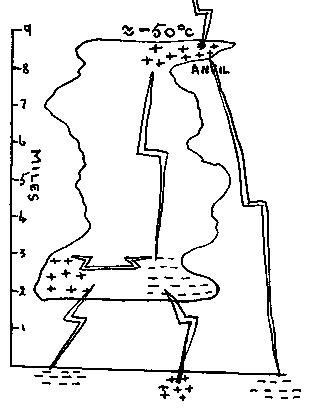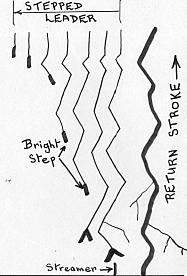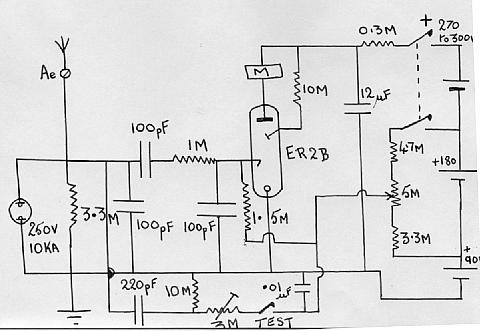
A Flash of Lightning
The Cumulo-Nimbus Cloud

Children used to call them Cabbage Clouds as the Cumulus billowed upwards on a Summer day. When convection carries one high enough its top its drawn outwards by the winds of the Stratosphere. It has the appearance of the beak of a blacksmith`s anvil.
Such a cloud is 50,000 feet or so high and its temperature at the top is - 50 degrees C. Its water mass is about 300,000 tons in the form of particles ranging in size from the Aitken nuclei a few microns in diameter to larger, visible, droplets a fraction of a millimetre in size.
If the air is free from nuclei, dust, pollen grains, meteoritic detritus, the water will be liquid and supercool.
The winds inside the cloud reach speeds of hundreds of miles per hour and circulate the water droplets and ice inside cells/regions within the cloud.
Regions of electrical charge build up within these cells - sometimes called thunder cells. Some may have net positive charge and some net negative charge. It is too simplistic to say that there is one polarity at the top of the cloud and its opposite at the base.
Forms of Lightning
I am refering here only to channel discharges of lightning. We usually see the return stroke oscillating between cloud and ground and cloud to cloud discharges. Inside the cloud may be intra-cloud lightning which lights up the cloud like an enormous glow discharge tube. Discharges may leave the top of the cloud and out into the ionised regions of the ionosphere.
A fighter pilot who bailed out inside a cumulo-nimbus went upwards! For three quarters of an hour he was lifted and dropped by the immense internal winds and described intra cloud lightning as `pillars of blue fire`.
Fork lightning is the name given to the common return discharge cloud to ground.
Sheet lightning is the lighting up of sky and clouds by unseen fork lightning.
Ball lightning denied existence for a long time. A.D. Moore told me of some he had seen. Shortly afterwards my wife was standing at a bus stop when lightning hit the road about twenty yards away and a blue ball nonchalantly bounced down the
I will return ball lightning later.
Bead lightning appears after a particularly powerful fork lightning. It looks like the lightning discharge channel has broken up into a string of beads - of plasma.
Ribbon Lightning. Powerful horizontal winds blow the fork lightning channel sideways. The appearance of the lightning is like a long flat ribbon reaching from cloud to ground.
From the origin to the discharge of a flash of lightning.
Sources of charge charging processes
Charging Process in Cumulo-Nimbus Decades of investigation have disvovered that:-
Ice impacting on ice produces electricity. Water freezing produces electricity. Water freezing - remelting - refreezing produces electricity. Water drops breaking up produce electricity. Droplets drawn out in electric fields redistribute electricity in themselves and add to total charge. Ingestion into the cloud of saline jet droplets from the seas and oceans contribute electricity.
In the Cumulo-Nimbus Cloud the winds, water and temperature generate electric charge.
The major question is not whether these produce electricity, they have been investigated at laboratory level and are known to be true, but does the charging process produce (i) sufficient charge (ii) If so does it do so quickly enough such that when a thunder cell discharges in lightning it can recharge - as is observed - within about thirty seconds?
Workman and others investigated warm clouds which also produced thunderstorms -which brings the ice factor into question.( They also found Cumulo-Nimbus 15miles high.)
Vonnegut did not accept these processes as being the main contributory source of electricity and regarded them as interesting secondary sources. He felt the cloud when it reached a certain height was an electrical conductor on which charge was induced from the ionised upp er atmosphere and Earth`s field.
One thing is certain somehow within the whirling of winds, ice and water charge accumulation takes place and builds up in `cells` with net pockets of charge, within the Cumulo-nimbus cloud.
An `Average`Lightning Flash Stephen Gray thought the sounds and sparks in his electrostatic experiments may well be going on in larger scale in thunderstorms.
The invention of the Leyden Jar concentrated minds in the same direction.The discovery that the Leyden Jar spark was oscillatory and not just a simple discharge led to the thought that lightning too may oscillate between cloud and ground - assuming of course that lightning was electrical.
Benjamin Franklin with his kite experiments, the experiment at Marly and others proved that lightning was indeed a gigantic electrical discharge.
But at what voltage? C.T.R. Wilson (Inventor of the Cloud Chamber to examine ions in the air on Ben Nevis) made the obvious common sense deduction, namely:
If a potential difference between electrodes of 10,000 volts produces a spark 1 cm long then a lightning discharge 2km long will have a potential difference between cloud and ground of:-
2 x 1000(metres) x 100 (cms) x 10,000 (volts) = 2,000,000,000volts.
THE BOYS LIGHTNING CAMERA.
C.V. Boys was a great experimental scientist. His little book Soap Bubbles - their colors and the forces which mold them, is a gem . Boys realised there were two possible ways to examine lightning by means of photography.
When you take a photograph you in effect stop the action of something so that you may examine it at leisure.
The many excellent lightning photographs now appearing on the Internet have, in each instance,captured a momentary flash of lightning. But how could you photograph it so quickly you could actually see how it travels through the air. The two possible ways are either to move the film at very high speed passed a fixed lens OR keep the film stationary and move the lens.
There is a kind of half way approach called streak photography in which both the lens and film are fixed - the shutter opened and the whole camera swung horizontally. This gives a streak photograph which can be examined to determine the locations of most intense light in the lightning channel.
Boys decided to move the lenses in front of a fixed film. The lenses in the Boys Camera rotated to give the effect of moving the film at 26,000 frames per second.
Charles Bruce told me that Boys carried the camera about with him for over twenty years and never got a photograph. The camera passed to Sir Basil Schonland investigating lighting in South Africa and he began to obtain photographs almost immediately.

A lightning flash resolved by Boys camera at 26,000 frames per second
A lightning flash starts downwards as a thin moving leader with a very luminous tip. The second tip advances in this the stepped leader by some 20 to 50 metres advance on the first step. The steps, sometimes branching, stab downwards until near to the ground.
Leader charge is negative and of about 5 coulombs over its entire length. Its downward velocity is 150,000 metres per second. The current in the tip is 100Amps.
On nearing the ground the intense electric field of the advancing stepped leader induces an image charge of opposite polarity in the ground and a streamer is initiated upwards. When the two meet a conducting path is established between cloud and ground.
A shock wave of gaseous plasma rushes along this path or channel created by the stepped leader and large currents flow to produce temperatures in excess of 30,000 degrees C. This large current discharge is called the return stroke.
Photographic measurements have established the diameter of the stepped leader channel as being from 1 to 10 metres with most of the charge flowing in a central channel or core surrounded by a corona sheath. The return stroke was once thought to be several metres in diameter but following Bruce`s glow to arc transition theory and prediction of a small diameter core, experimental and observational evidence has established the core to be some 2 square millimetres in cross sectional area.
The return stroke may be the end of the dischage process but very often a second no-stepped leader will discharge along the ionised channel and intitaes a second return stroke. Uman cites one lightning flash which repeated 26 times before ceasing.
A further phenomena, the M component, is a sudden increase in the luminosity of the entire channel following the return stroke.
Characteristics of an `average` lightning flash:-
Stepped leader takes 0.005 secs to develop.
Return stroke takes 0.0001secs (about 1/3 the speed of light).
Return stroke
200,000,000 volts potential over length.
Current 50,000 Amps.
Core temperature 25,000 C (about 5x hotter than surface of the Sun).
Length 5 miles.
There are 1200 thunderstorms per hour over the Earth`s surface. Each will have about 1,000 flashes of lightning. A thunder cell within a cumulo-nimbus cloud recharges in 30 seconds.
Empire State Building
Observations of lightning at the Empire State Building in the 1940s called into question the `common-sense` estimate of 2,000 million volts potential across a lightning discharge. Already it had been determined that a charge of 20 t0 30 coulombs was being cancelled over an area of about 100 square km then the electrostatic field must be more in the range of 300 Volts per cm and not 10,000 Volts per cm predicted by the `common-sense` estimate. This put the potential in the region of 50 million volts and not 2000 million volts.
The top of the Empire State Building should have been at 2 million volts with respect to the ground level. But field values of 100 to 200 Volts per cm were recorded. Also many strokes were seen to be initiated upwards from the lightning conductors.
Dr.C.E.R.Bruce had been recommended to the Electrical Research Association by his mentor Sir Edmund Whittaker. He had worked on statistics and features of the arcs produced by circuit breakers on the National Grid. He was requested to investigate the earthing of the Grid steel pylons by a wire which was attached at the highest point and went from pylon to pylon. The idea was a common-sense one of a kind of continuous lightning conductor.
Bruce began an intensive study of lightning and looked at the results from Empire State Building. He considered the lower than expected field potentials and compared these with 10million volt flashes to transmission lines and moving film camera photographs and measurements of return stroke currents of 10 to 20,000Amps.
The diagrams show that the stepped leader advances in a thin channel which has a very luminous tip.
Bruce had his associates set up an experiment in which a steel gramophone needle represented the Empire State Building. A 2million volt spark was initiated from the needle to a metal plate 2metres above. From this Bruce determined the return stroke velocity to be about 30 million metres per second and also made an important observation about the pre-discharge condition.
The difficulty as he saw it was in trying to explain the spark assumption which required a build up to 2000 million volts before a lightning discharge. The simple spark discharge idea did not fit with the complex stepped leader process revealed by Boys and moving film cameras. The low measurements from the Building observations did not fit either.
A quick look at Volt Ampere characteristics: -
For a spark discharge the Volt Ampere Characteristic is Positive. That is as the voltage increase the current increases. In other words more volts give more amps in current.
For an arc discharge the Volt Ampere characteristic is Negative. That is as the current increases the voltage either diminishes or remains constant. More current for the same or less voltage.
The Glow to Arc Transition Theory of Lightning
Bruce considered the recent paper by Merrilland Von Hippel on Lichtenberg`s Figures (see Lichtenberg Figures) and their explanation of the advancment process of the branches of the discharge figures. The idea applied to the lightning is that since the potential of the stepped leader tip to the surrounding air is 100 million volts there will exist a corona or brush discharge surrounding the tip. And since the current is 100 Amps it must supply both the existing thin channel and the brush discharge.
At the tip after an advance more charge is conducted along the channel to the region of the tip. Corona discharge takes place with phto liberation of ions in the air ahead of the advancing leader. At this time the volt ampere characteristic is positive - as voltage increases current increases.
When the current feeding the corona reaches a value of 1 Amp it is known from laboratory studies of electric arcs (in arc welding for example) that the volt ampere characteristic goes negative. That is the voltage no longer increases but the current does. This must occur at the tip of the stepped leader. The voltage now needed to maintain the arc is tens not thousands of volts. The sudden increase in current at the tip increases ionisation and electromagnetic radiation some of which is seen as the increased luminosity of the tip.
In the stepped leader of a developing lightning flash the tip of the leader undergoes a corona glow to a current arc transition.
There is no need for a build up of potential between cloud and ground to cause a spark discharge across the whole distance/length and requiring thousands of millions of volts.
What does happen is that in the cloud or at its base corona discharges begin to appear into the surrounding air which is at a lower potential than the cloud. When the current in one of these regions of corona reaches 1 ampere there is a glow to arc transition which initiates the first step. A central core carrying hundreds of amps,an arc, develops surrounded by a corona sheath. The core is some 10million volts to the surrounding air.
When the return stroke takes place tens or hundreds of thousands of amps travel through the core. Bruce proposed that this arc would vapourise material at the earth surface. The arc - lightning channel would of course be surrounded by a powerful magnetic field which crushed the conducting channel and travelled upwards with the return stroke current. Spectral examination should therefore reveal lines of materials vapourised at the surface and taken up into the lightning channel.
Isreal and Wurm made the first spectroscopic examinations and found lines including those of iron reaching some 2 meters above the ground.
The magnetic pinch effect led Bruce to calculate the diameter of the lightning channel core at about 1 cm. Experiments with copper tipped masts and holes pierced by lightning in fibre glass have confirmed this value.
Thus it is that within a few milliseconds a glow beneath a cloud establishes a small current which becomes an arc and stabs its way through the air as a stepped leader. Until a return stroke carrying thousands of amperes and producing thousands of degrees temperature rise rushes up into the cloud and neutralises charge in the lower cell regions. Within milliseconds a dart leader from higher in the cloud rushes down the recent still ionised conducting channel and initiates another return stroke. All we see is a momentary flash. Fifteen to twenty seconds later the cell is re charged and ready to fire again. The great increase in temperature in the advancing channel sends out a cylindrical sonic wave which rolls outwards as thunder. You see the flash - begin counting in seconds -hear the thunder stop counting. Divide by 5 and you have the distance away of the flash in miles. (Scared rabbits like me tend to count faster!!! Doesn`t work though.)
The lightning discharge is oscillatory and as it changes polarity back and forth and ions rush up and down the channel it emits radio waves which bounce off the ionosphere round and round the world - they can be heard as Whistlers. There are Web pages devoted to these and include some recorded sounds.
I asked Bruce for his ideas on Ball Lightning. He made a reasonable suggestion that if you think about the lightning channel - imagine a straight piece - current is travelling along it and surrounds it with a magnetic field, the pinch effect of which is to crush the channel. Not many lightning channels are straight - think now of a place where it kinks - a bend will have the magnetic field more spread out on the outside and more concentrated on the inside of the bend. If the channel ruptures - albeit briefly - some of the ionised plasma will escape.
The natural shape of a free fluid is spherical so the escaped blob of plasma is spherical.
"Many accounts of Ball lightning tell of it moving horizontally how would you explain that?"
He took out a match and struck it -lit his cigar - and flicked the still lit match horizontally across the room.
A Lightning Flash Counter

My lightning flash counter last used in the 1970s. A modified version of R.H. Golde`s circuit it worked very well. I include it not as a suggestion to build it but hope that someone familiar with modern electronics may come up with a modern version.
M is a post office meter - small solenoid operated counter.